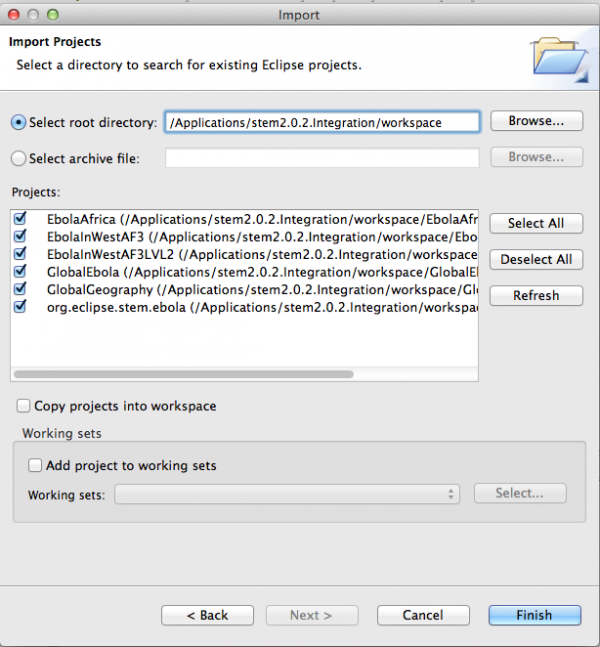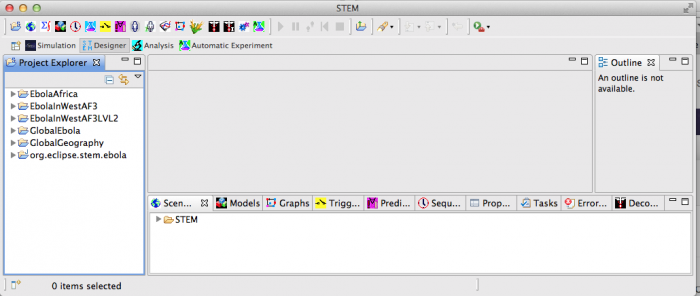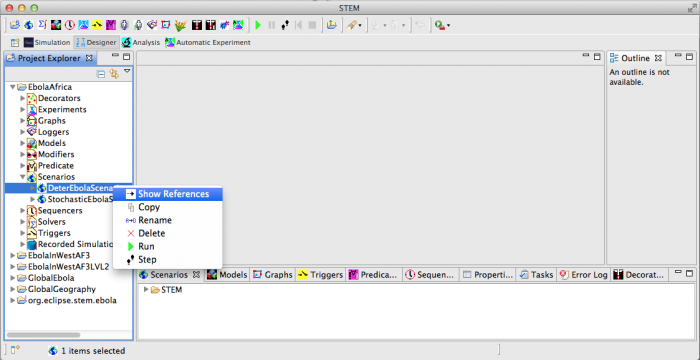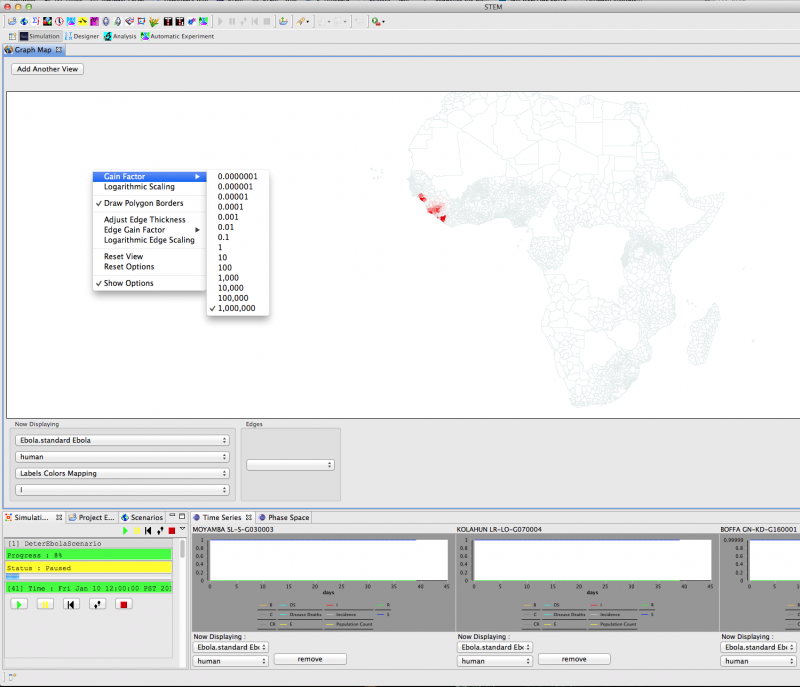Notice: This Wiki is now read only and edits are no longer possible. Please see: https://gitlab.eclipse.org/eclipsefdn/helpdesk/-/wikis/Wiki-shutdown-plan for the plan.
Difference between revisions of "Ebola How To"
| Line 38: | Line 38: | ||
[[Image:SelectAllEbola.png|600px]] | [[Image:SelectAllEbola.png|600px]] | ||
| − | 13. After the import completes | + | 13. After the import completes the Designer perspective of your workspace should look something like this |
[[Image:EbolaWorkspace1.png|700px]] | [[Image:EbolaWorkspace1.png|700px]] | ||
| + | |||
| + | 14. The project folders you see include: | ||
| + | |||
| + | * EbolaAfrica (all of Africa Admin Level 2) | ||
| + | * EbolaInWestAF3 (3 countries in: Wst Africa, GIN, LBR, SLE. This is Level 0, a very simple 3 patch model but one that can be used to fit model parameters to data emerging for those three countries) | ||
| + | * EbolaInWestAF3LVL2 (Same as above but at Admin Level 2) | ||
| + | * GlobalEbola (The whole world. See the instructions on running the [[Global Ebola Model]] to learn how to change your memory settings to run this. | ||
| + | * GlobalGeography (reference data required to run the global model above) | ||
| + | * org.eclipse.stem.ebola (The model itself. See the page the [[STEM Model Creator]] to see how to view and edit the model and to view the generated source code inside) | ||
[[Image:EbolaWorkspace2.png|700px]] | [[Image:EbolaWorkspace2.png|700px]] | ||
[[Image:RunEbola.png|800px]] | [[Image:RunEbola.png|800px]] | ||
Revision as of 15:45, 29 September 2014
Under construction How to install and run the Ebola Models
You can download the ebola models here.
This archive contains multiple projects and multiple scenarios for Ebola. The archive also contains the Ebola model itself which can be opened and edited with the STEM model generator. For more information on the model itself please see the page Ebola Models.
To install the models:
1. Install the latest weekly integration build of STEM.
2. In the event we later release new versions of the Ebola models that depend on climate factors around the globe. We suggest you also install the global data on climate and environmental factors.
3. Download the Ebola Models as a single archive.
4. Extract the Archive so all the project folders it contains are in one single place.
5. Navigate to your STEM installation folder. Then navigate to the folder workspace
6. Move or copy all the project folders from step 4 into the folder workspace.
7. Launch STEM. Just click on the STEM icon in your install folder. After STEM launches
- close the welcome page
- switch to the Designer perspective (the tab at the top).
8. From the menu bar select >File>import
9. Select >General>Existing Projects into Workspace. Click Next.
10.Click Browse. Then navigate to your STEM Workspace folder if it does not already appear.
11. Click Open
12. You should see 6 separate Ebola related project folders, all selected, as shown in the image below. Click Finish.
13. After the import completes the Designer perspective of your workspace should look something like this
14. The project folders you see include:
- EbolaAfrica (all of Africa Admin Level 2)
- EbolaInWestAF3 (3 countries in: Wst Africa, GIN, LBR, SLE. This is Level 0, a very simple 3 patch model but one that can be used to fit model parameters to data emerging for those three countries)
- EbolaInWestAF3LVL2 (Same as above but at Admin Level 2)
- GlobalEbola (The whole world. See the instructions on running the Global Ebola Model to learn how to change your memory settings to run this.
- GlobalGeography (reference data required to run the global model above)
- org.eclipse.stem.ebola (The model itself. See the page the STEM Model Creator to see how to view and edit the model and to view the generated source code inside)




